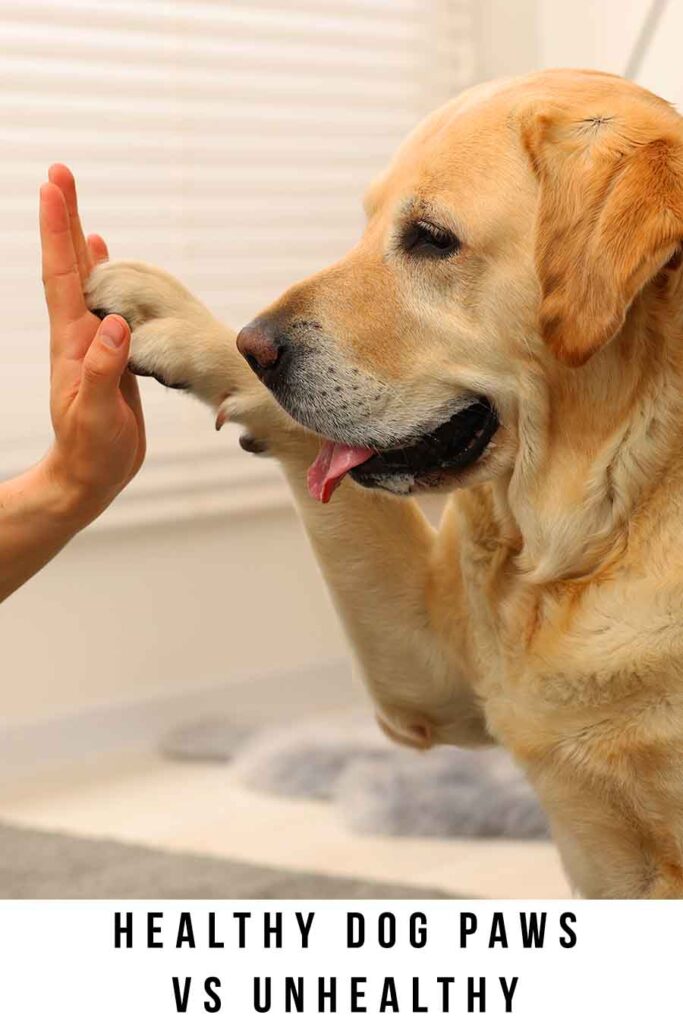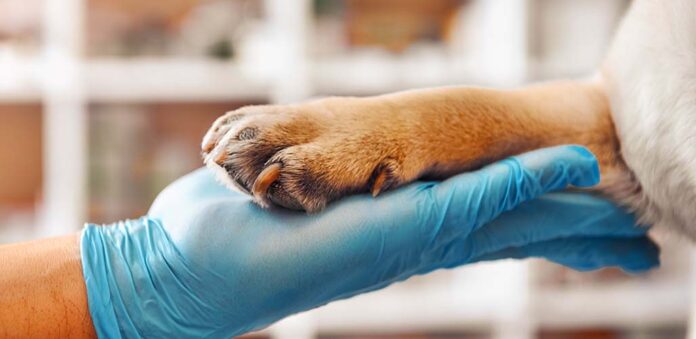As a dog owner it’s natural to be concerned about all aspects of their health, and this includes the difference between healthy dog paws vs unhealthy. Dogs’ feet have nothing between them and the ground to protect them, so they are vulnerable to damage. And when a dog’s paws are injured or diseased, it’s nearly impossible for them to continue moving around in a pain-free way. Diseases, parasites, allergies and injuries can all trigger paw problems, and there’s a lot of overlap between their symptoms. Here’s how to tell the difference between a healthy dog paw and an unhealthy dog paw, and what to do when you spot signs of trouble.
Contents
- What do healthy dog paws look like?
- Causes of paw problems
- How to spot the signs of unhealthy paws
- Protecting your dog’s paws
What do healthy dog paws look like?
Let’s start with what you’re looking for in healthy dog paws. Puppies are born with wonderfully soft and squashy paw pads, but the skin covering them gradually gets thicker and rougher with use. This change means they’re less likely to be cut or damaged by walking on rough terrain. It also gives your pet more traction on smooth surfaces. Despite the fact that dogs walk around with nothing between their feet and the ground, healthy paws are very clean. In fact they have far fewer bacteria on them than the soles of our own shoes!
The fur on your dog’s feet should be even, clean and dry, without any bald spots, and the skin underneath should be smooth and supple. The nails should be short enough that they don’t touch the ground. When your dog stands and moves around, each paw should bear its fair share of their weight evenly and comfortably.
Healthy dog paws do have a distinctive odor, which is similar to corn chips or popcorn. This smell comes from harmless bacteria living on their skin, and most dog owners find it inoffensive. Healthy paws may also sweat occasionally, either due to hot weather or stress (for example leaving sweaty paw prints on the veterinarian’s examination table).

Causes of paw problems
Now let’s turn to healthy dog paws vs unhealthy paws, and how the sickly ones measure up. The causes of unhealthy paws fall into seven categories:
- Immunological
- Parasitic
- Acquired
- Metabolic
- Infectious
- Cancerous
- Inherited
Immunological
Immunological paw conditions are things like vasculitis, which means inflammation of the blood vessels, allergies, and atopic dermatitis, which is itchy, flaky, dry and cracked skin. Both problems are caused by your dog’s immune system launching an inappropriate response where it isn’t needed. The paws are the most common site for atopic dermatitis lesions on dogs, and some breeds, like Labradors, are more prone to developing them than average.
Parasitic
Several parasites can be enemies of good paw health. Ticks are notorious for hiding out between dogs’ toes or in the cavity between their metacarpal paw pad and digital paw pads ( a.k.a. the big pad and the toe beans!). Dogs with a flea bite allergy might also suffer particularly from flea bites to their feet, because being accessible to chew them means they’re slower to heal. Some are paw parasites are even invisible – for example Demodex mites, which live deep down inside the hair follicle.
Acquired
Acquired problems that can afflict previously healthy dog paws are things like:
- Cuts
- Abrasions
- Fracture
- Burns
- Chemical damage from substances like rock salt
- Embedded objects like thorns or glass
- Overgrown or split nails
In other words, events that can mostly be described as injuries. Taken all together, this category accounts for a lot of canine experiences with unhealthy feet.
Metabolic
‘Metabolic’ means relating to the chemical processes which go on inside a dog’s body. Some abnormalities or failures of these processes can symptoms in dogs’ paws. For example, late stage liver failure causes thickened paw pads which crack and ulcerate easily. Since dogs instinctively mask the pain from internal disorders for as long as possible, external symptoms like visibly unhealthy paws can be one of the first signs an owner spots.
Infectious
Infectious paw ailments are are usually secondary to another problem, like atopic dermatitis, or a cut on the paw pads. When the skin barrier is broken, disease causing pathogens like fungi and bacteria are able to enter the foot, and cause deep-rooted infections.
Cancerous
Dogs can develop cancerous tumors almost anywhere, including on their feet. Some cancers are even paw-specific, such as nail bed squamous cell carcinoma. Cancer is more common in large dog breeds like Labradors, Standard Poodles and Rottweilers.
Inherited
Finally, there is a small and relatively rare group of genetic disorders which are characterized by diseased paw pads. These include congenital cornification disorder and familial paw pad hyperkeratosis. In both of these conditions, dogs’ paws are dry and scaly, and the skin cells proliferate too quickly, causing the pads to become thick and cracked. The nails are usually deformed too.
How to spot poor paw health
Correctly diagnosing the different types of unhealthy dog paw is notoriously difficult. The symptoms all overlap, no matter what the underlying cause. So, it’s important to never try and make your own diagnosis. Always visit a vet if you see any of the following symptoms affecting your dog’s feet:
- Inflammation or swelling
- Broken skin, including cuts, lesions, ulcers and blisters, regardless of whether it is bleeding
- Dry or cracked pads
- Hair loss
- Fur which appears wet all the time
- Changes in the color of the skin, including redness, or depigmentation of the pads
- Changes in the texture of the skin, including thickening or flakiness
- Limping, or avoiding bearing their weight on a specific paw or paws
- Aggressively or obsessively licking or chewing their feet
- Lumps, bumps, growths, cysts or nodules anywhere on the foot
- A bad smell or increase in smell
- Cracked or torn nails
Your vet will take a full medical history, ask you lots of questions, and possibly conduct tests such a skin scraping, or a biopsy. They will also help you plan the most appropriate course of treatment, which will depend on the underlying cause.
Protecting your dog’s paws
When it comes to maintaining healthy paws vs unhealthy, there’s one old adage which is particularly apt: prevention is better than a cure. In other words, it’s better to keep your dog’s feet fit in the first place, than neglect them and have to nurse them back to health. Healing unhealthy dog feet is often challenging, because they’re never out of use. Here’s how keep your dog’s paws well:
- Clean and dry them after walks.
- Trim the fur between their toes to prevent it trapping moisture or irritating the skin.
- Don’t let your dogs walk on hot sidewalks in summer or salted sidewalks in winter without boots.
- Trim their nails regularly.
- Check the paw pads, between the toes, and under the fur regularly for early signs of illness.
Healthy dog paws vs unhealthy – summary
When a body part is in constant use, and in direct contact with many different surfaces, it’s important to look after it. Which is why it’s important to be able to recognize the difference between healthy dog paws and unhealthy ones. Check your pup’s feet frequently, and report any changes in them, or signs that they’re making your pet uncomfortable, to your vet. Do not attempt to diagnose the cause of unhealthy feet yourself, since the ways in which the many possible causes can present themselves are only subtly different.
The Labrador Site Founder
Pippa Mattinson is the best selling author of The Happy Puppy Handbook, the Labrador Handbook, Choosing The Perfect Puppy, and Total Recall.
She is also the founder of the Gundog Trust and the Dogsnet Online Training Program
Pippa's online training courses were launched in 2019 and you can find the latest course dates on the Dogsnet website



















